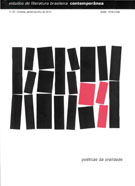A poética cantada:
investigação das habilidades do repentista nordestino
Resumo
O repente ou cantoria é uma arte poético-musical comum no Nordeste do Brasil e caracteriza-se pela improvisação de estrofes, ou seja, pela sua composição no momento da apresentação. Cantando sempre em duplas, ao improvisar versos os repentistas dialogam um com o outro e com os ouvintes. E colocam-se em relação com modelos estéticos incorporados, como as regras poéticas, os padrões melódicos e harmônicos, os moldes rítmicos da poesia, as temáticas usuais etc., a partir dos quais devem criar textos originais. No improviso, o cantador guia-se por esses modelos estéticos, dentre os quais ressalto como o principal fundamento prático do repente o ritmo poético incorporado por esses poetas.
Downloads
Referências
AYALA, Maria Ignez Novais (1988). No arranco do grito: aspectos da cantoria nordestina. São Paulo: Ática.
CROOK, Larry (2005). Brazilian music: Northeastern traditions and hertbeat of a modern nation. Santa Barbara/Denver: Oxford/ABC-Clio.
DÃAZ-PIMIENTA, Alexis (2001). Teoría de la improvisación: primeras páginas para el estudio del repentismo. Habana: Unión de Escritores y Artistas de Cuba.
EGAÑA, Andoni (2005). “The process of improvised bertsoak”. In: ARMISTEAD, Samuel e ZULAIAKA, Joseba (orgs.) Voicing the moment: improvised oral poetry and basque tradition. Reno: University of Nevada. p. 323-40.
GONÇALVES, Marco Antonio (2007). “Cordel híbrido, contemporâneo e cosmopolita”. Textos escolhidos de cultura e arte populares. v. 4, n. 1, p. 21-38.
JAKOBSON, Roman (1966). “Grammatical parallelism and its Russian facet”. Language. v. 42, n. 2. p. 399-429.
______ (1975). Lingüística e comunicação. São Paulo: Cultrix.
KUBIK, Gerhard (1979). “Pattern perception and recognition in African music”. In: BLACKING, John e KEALIINOHOMOKU, Joann (orgs.). Performing arts: music and dance. The Hague: Mouton. p. 221-49.
LORD, Albert Bates. (2000). The singer of the tales. Cambridge: Harvard University Press.
MAGRINI, Tullia (1998). “Improvisation and group interaction in Italian lyrical singing”. In: NETTL, Bruno e RUSSELL, Melinda Russell (orgs.). In the course of performance: studies in the musical improvisation. Chicago/University of Chicago Press. p. 169-98.
NETTL, Bruno (1974). “Thoughts on improvisation: a comparative approach”. The musical quarterly. v. 60, n. 1. p. 1-19.
______ (1998). “Introduction: an art neglect in scholarship”. In: NETTL, Bruno Nettl e RUSSELL, Melinda (orgs.). In the course of performance: studies in the musical improvisation. Chicago/ University of Chicago Press. p. 1-23.
OLIVEIRA, Luciano Py de (1999). A música na cantoria em Campina Grande (PB): estilo musical dos principais gêneros poéticos. (Dissertação de Mestrado). Universidade Federal da Bahia, Escola de Música, Salvador.
RAMALHO, Elba Braga (2000). Cantoria nordestina: música e palavra. São Paulo: Terceira Margem.
______ (2001). Cantoria nordestina: proposta de um novo enredo para o metro cantado. Tese apresentada em concurso para Professor Titular. Universidade Estadual do Ceará, Centro de Humanidades, Fortaleza.
SUTTON, R. Anderson (1998). “Do Javanese gamelan musicians really improvise?” In: NETTL, Bruno e RUSSELL, Melinda (orgs.). In the course of performance: studies in the musical improvisation. Chicago/ University of Chicago Press. p. 69-92.
SAUTCHUK, João Miguel (2009). A poética do improviso: prática e habilidade no repente nordestino. Tese. Universidade de Brasília, Brasília.
TAMBIAH, Stanley Jeyaraja (1985). “A performative approach to ritual”. In: Culture, thought and social action. Cambridge/Harvard University Press. p. 123-66.
TRAVASSOS, Elisabeth (1989). “Melodias para a improvisação poética no Nordeste: toadas de sextilhas segundo a apreciação dos cantadores”. Revista brasileira de música. n. XVIII, p. 115-29.
WATEAU, Fabienne (2005). “Défi s esthétiques et défi s ordinaires, essai d’interprétation de joutes verbales et ritualisées au Portugal”. Ethnographiques.org 7 Disponível em: <http://www.ethnographiques.org/2005/Wateau.html> Acesso em: 6 abr 2007.
WHITE, Linda (2005). “Formulas in the mind: a preliminary examination to determine if oral formulaic theory may be applied to the Basque case”. In: ARMISTEAD, Samuel e ZULAIAKA (orgs.) Voicing the moment: improvised oral poetry and Basque tradition. Reno/University of Nevada, Center for Basque Studies. p. 265-80.
ZÉ MARIA DE FORTALEZA (José Maria do Nascimento). (s.d.) Curso prático de literatura de cordel. Manuscrito.
Downloads
Publicado
Como Citar
Edição
Seção
Licença
Autores que publicam nesta revista concordam com os seguintes termos:
a) Os(as) autores(as) mantêm os direitos autorais e concedem à revista o direito de primeira publicação, sendo o trabalho simultaneamente licenciado sob a Licença Creative Commons de Atribuição-Não Comercial 4.0, o que permite o compartilhamento do trabalho com reconhecimento da autoria do trabalho e publicação inicial nesta revista.
b) Os(as) autores(as) têm autorização para assumir contratos adicionais separadamente, para distribuição não-exclusiva da versão do trabalho publicada nesta revista (ex.: publicar em repositório institucional ou como capítulo de livro), com reconhecimento de autoria e publicação inicial nesta revista.
c) Autores têm permissão e são estimulados a publicar e distribuir seu trabalho on-line (ex.: em repositórios institucionais ou na sua página pessoal) após o processo editorial, já que isso pode gerar alterações produtivas, bem como aumentar o impacto e a citação do trabalho publicado (Veja O Efeito do Acesso Livre).
d) Os(as) autores(as) dos trabalhos aprovados autorizam a revista a, após a publicação, ceder seu conteúdo para reprodução em indexadores de conteúdo, bibliotecas virtuais e similares.
e) Os(as) autores(as) assumem que os textos submetidos à publicação são de sua criação original, responsabilizando-se inteiramente por seu conteúdo em caso de eventual impugnação por parte de terceiros.


